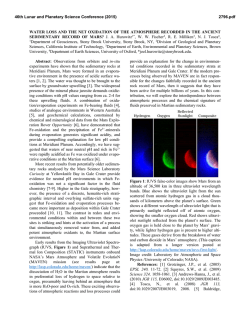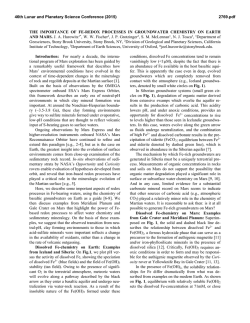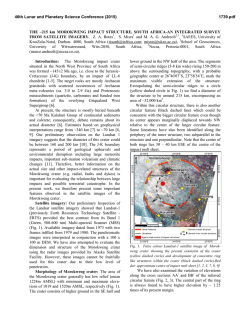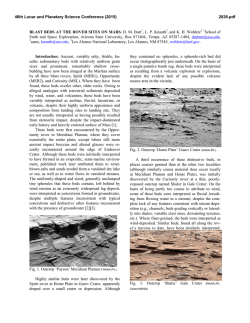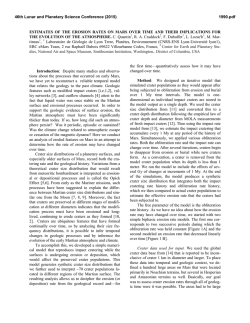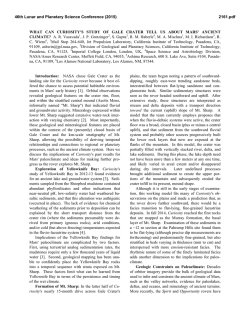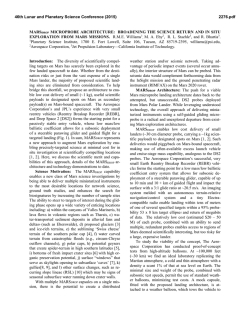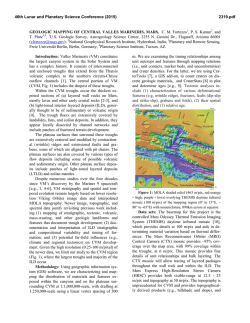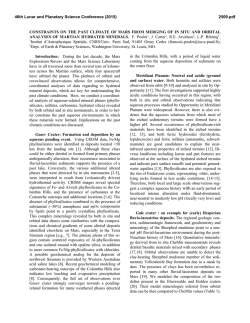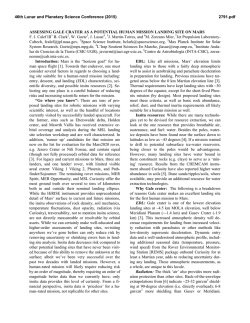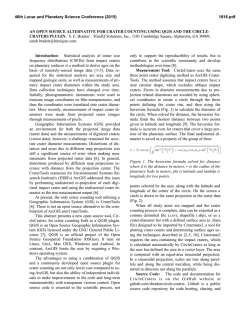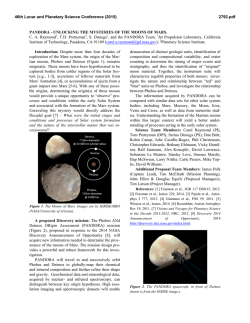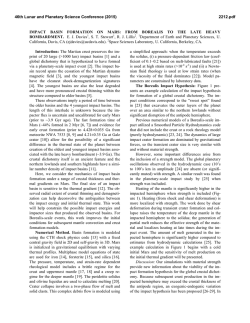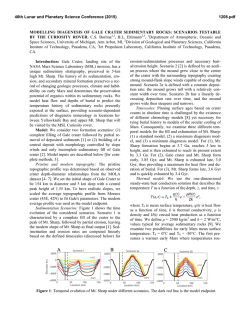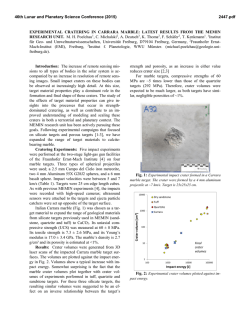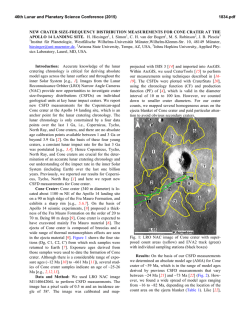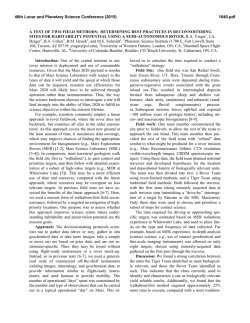
SEDIMENTARY EARLY MARS REVEALED AT THE MICROSCALE
46th Lunar and Planetary Science Conference (2015) 1378.pdf SEDIMENTARY EARLY MARS REVEALED AT THE MICROSCALE: THE GALE CRATER EXAMPLE. R.A. Yingst1, K.S. Edgett2, M. McBride2, M. E. Minitti1, K. Stack3, and W. Goetz4. 1Planetary Science Institute (1700 E. Fort Lowell, Suite 106, Tucson, AZ 85719; [email protected]), 2Malin Space Science Systems, San Diego, CA, 3JPL, Pasadena, CA, 4Max Planck Institute for Solar System Research, Göttingen, Germany. Introduction: Mars is a world of sediment, and the platforms and tools are available to investigate Martian sediments at a microscopic scale. Lithological features involving grains and grain relationships (0.5-10 mm in scale) provide key indicators of rock-forming environments. A hand sample alone, examined with a hand lens, can provide data sufficient to identify both rock forming processes and secondary modification. Particle shape and size distribution, and surface textural characteristics of sediments, are diagnostic of wind and water activity that is expressed in sediment transport and soil processes such as cementation, percolation and chemical weathering. Expressions of rock texture at this scale are thus critical to interpreting present and past geologic environments. In situ observations by the Microscopic Imager on the Mars Exploration Rover Opportunity revealed numerous sedimentary structures indicating both eolian and fluvial deposition mechanisms, the latter including cm-scale festoon cross lamination [1]. While not positioned to observe in situ sedimentary structures, the Phoenix lander observed flat and rounded particles, the first potentially indicating clay and the second indicating significant wear [2]. Here we focus on Martian sedimentary processes revealed in Gale crater by submm to mm-scale in situ observations. Field site: The Gale Crater floor is dominated by a ~5 km high mound of stratified rock (informally known as Mt. Sharp) that is assumed to be fill material deposited as sediment. MSL landed northwest of the mound. Within the landing ellipse is an alluvial fan (Peace Vallis Fan) that transported alluvium from the crater rim, across the landing ellipse, and toward a topographic low at the base of Mt. Sharp [3]. Sediment from the walls of fluvial canyons that debouch onto the crater floor, fragments shed from the upper and lower mound strata, impact materials, and grains from modern eolian dunes, also likely contribute to the inventory of sedimentary materials. Observations: From orbit, Mars is a basaltic planet in composition, in spectral character, and in many places, geomorphically. However, within Gale crater, sedimentary processes comprise the dominant interpretation for structures and textures. The Mars Science Laboratory (MSL) Mars Hand Lens Imager (MAHLI [4]) acquired sub-mm/pixel scale color images of over 70 individual rocks and outcrops during the mission’s first Martian year, permitting the study of textures down to the distinction between silt and very fine sand. Observed rock textures classed based on their grain size, sorting, matrix characteristics, and abundance of pores. Because the recent campaign at Pahrump Hills (starting ~sol 750) acquired many more MAHLI images than elsewhere along the traverse [5], textural analysis there is more detailed and thus types observed there also are sub-divided. Mudstones. These rocks contain framework grains smaller than the highest resolution MAHLI images (16 µm/pixel), and thus are interpreted to consist of grains that are silt-sized or smaller. Some rocks contain nodules, sulfate veins, and Mg-enriched erosionallyresistant ridges (Figure 1). The Pahrump Hills region contains mudstones of at least four different sub-textures: recessive massive, recessive parallel-laminated, recessive laminated-tomassive, and resistant cross-stratified [5]. Recessive mudstones are slope-forming; parallel-laminated resistant mudstones display mm-scale parallel (and in some cases rhythmic) lamination that extends laterally for many meters, and are interbedded with recessive massive mudstones. Coarse cm- to mm-scale laminae appear within resistant mudstones (e.g., Figure 2), though some portions are more massive; laminae tend to be traceable for cm to meters. Figure 1. Wernecke brushed target, Sheepbed unit, acquired sol 169 at 17 µm/pxl (2.9 cm working distance). Scene is ~27 mm wide. Filled and hollow nodules give the rock a knobby texture. Note vein and filled nodule (CaSO4) near the right edge. Image 0169MH0001630000102232R00. Well-sorted sandstones. Rocks in this class are made of gray, fine-to-medium sand and exhibit little to no porosity. Two examples of this class show fine lin- 46th Lunar and Planetary Science Conference (2015) eations with sub-mm spacing. Aillik, a target in the Shaler outcrop, shows abundant cross-lamination. The Pahrump Hills region contains a sub-texture of wellsorted, very fine to fine-grained cross-stratified sandstone at the dune and ripple-scale [5]. 1378.pdf Pebbly sandstones. This texture is characterized by a poorly-cemented, poorly sorted matrix of coarse sand to granules, with a variety of colors and lusters. Whereas two endmembers in this class (Bardin Bluffs and Altar Mountain) have a similar fine-grained matrix, Bardin Bluffs (Figure 4) displays a fining upwards texture and grain-to-grain contact; the stratigraphically lower Altar Mountain does not. Altar Mountain and Bardin Bluffs both represent outcrops believed to represent conglomerates (e.g., [6]). Figure 2. Portion of image 2 of 5 acquired of the Chinle target on sol 828 at 40 cm working distance. Because the landscape slopes away from the camera, the image has a range of resolutions. At mid-height the scene is 200 mm wide. Image 0828MH0004520020301655C00. Poorly-sorted sandstones. This class is subdivided into two sub-classes: rounded, coarse-to-very coarse sand grains of variable colors and lusters, set in gray, fine sand (Figure 3); and dark gray, well-cemented, and fine grained, with rare pebble-sized clasts. The latter also exhibits pores or vugs that may have resulted from removal of these larger clasts. Figure 3. Gillespie Lake target acquired sol 132 at ~30 µm/pxl (6.9 cm working distance). Image is ~50 mm wide. Inset magnifies a bright resistant grain (~1 x 2 mm) and surrounding vuggy rock texture (from lower left corner of the background image). Image 0132MH0001580010101221C00. Figure 4. Bardin Bluffs target, acquired sol 394 at ~30 µm/pxl (6.9 cm working distance). Scene is ~50 mm wide. Image 0394MH0003060020104415C00. Massive and Vuggy rocks. These two classes both contain gray, fine-grained rocks. Though interpreted to be igneous earlier in the mission, many occur in a clear sedimentary context, suggesting that differences in grain characteristics and relationships stem from variations in cementation and/or weathering history. Discussion: In general, rock textures indicate fluvial or possibly lacustrine sediments; MAHLI has not unambiguously identified eolian or igneous rock textures, although some pebble-sized clasts may have an igneous provenance and some might derive from impact melt. References: [1] Grotzinger, J., et al. (2006), Geology, doi: 10.1130/G22985A.1. [2] Smith, P., et al. (2009), Science, v.325, 58-61. [3] Palucis, M., et al. (2014), JGR, doi: 10.1002/2013JE004583. [4] Edgett, K.S., et al. (2012), Space Sci. Rev., doi:10.1007/s11214-012-9910-4. [5] Stack et al., this volume. [6] Williams, R.M.E., et al. (2013), Science, doi:10.1126/science.1237317.
© Copyright 2026
